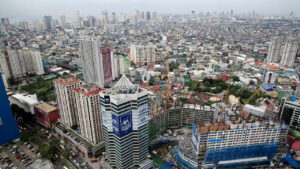FITCH SOLUTIONS Country Risk and Industry Research said it raised its 2022 gross domestic product (GDP) growth forecast for the Philippines to 6.6%, citing its better-than-expected economic performance in the first half.
The full-year outlook factors in an expected growth slowdown in the second half due to headwinds in the global economy, Fitch Solutions said.
In a note on Thursday, Fitch Solutions said the new outlook represents an upgrade from the 6.1% estimate it issued in May. Its new forecast falls within the government’s 6.5% to 7.5% full-year target.
“The slowdown in growth (during the second quarter) was in line with our expectations, although the pace of deceleration — from 8.2% in Q122 to 7.4% in Q222 — was more modest than we had predicted,” Fitch Solutions said.
GDP growth in the second quarter slowed significantly from the 12.1% posted a year earlier, according to preliminary data from the Philippine Statistics Authority (PSA).
In the six months to June, GDP growth averaged 7.8%.
“Overall, GDP growth in H122 benefited from the reopening of borders in February and election-related spending. Moreover, a relatively accommodative central bank has also supported consumption and investment to some extent,” Fitch Solutions said.
The Philippines reopened its borders for foreign visitors on Feb. 10. As coronavirus infections declined, Metro Manila and many other areas have been placed under the most permissive quarantine level since March.
The Philippines conducted national elections on May 9, with President Ferdinand R. Marcos, Jr. and Vice-President Sara Duterte-Carpio winning by a landslide.
“These tailwinds helped offset external headwinds stemming from elevated energy prices, a slowdown in the world economy, and tightening global monetary conditions. However, we believe that these tailwinds will continue to fade over the coming months, while growth headwinds intensify, leading to slower growth in H222,” Fitch said.
Preliminary data from the PSA show the consumer price index rising 6.4% year on year in July, driven by food and transport costs.
July headline inflation was the highest in nearly four years, or since the 6.9% posted in October 2018.
In the year to date, inflation averaged 4.7%, against the 4% from a year earlier. This was also lower than the 5% forecast of the central bank. Inflation remains persistently above the 2-4% target band set by economic managers for the year.
“Against the backdrop of the ongoing Russia-Ukraine war and adverse weather conditions in a number of food-producing countries in the region, energy and food prices will continue to be a significant source of upward price pressure in the Philippines,” Fitch Solutions said.
The Bangko Sentral ng Pilipinas (BSP) has hiked benchmark rates by a total of 125 basis points (bps) so far this year, including the outsized 75-bp increase in an off-cycle move on July 14, to temper rising inflation expectations.
BSP Governor Felipe M. Medalla has signaled an increase of 25 bps or 50 bps at the monetary board’s Aug. 18 meeting and said further increases would be data dependent.
“We expect more monetary tightening by the BSP and central banks in developed markets over the coming months which will weigh on investment, and to an extent, private consumption,” Fitch Solutions said.
Fitch Solutions also expects the central bank toll hike rates by an additional 100 bps in its next meetings, bringing the policy rate to 4.25% by year-end.
The IBON Foundation, Inc. think tank called for more determined government action, with the growth slowdown in the second quarter reflecting a weakening recovery.
“Reopening the economy is not enough because too many Filipinos are still jobless, earn too little, and are forced to lower their consumption by inflation,” IBON said in a statement on Wednesday.
“Despite the economy reopening, the household spending of millions of Filipinos is repressed by high unemployment, (and the) pervasive poor quality … of work,” the group added.
According to preliminary estimates by the PSA in its Labor Force Survey, unemployment was 6% in June, unchanged from May.
However, the total number of unemployed hit 2.990 million in June, 62,000 higher compared to May.
According to IBON Foundation, inflationary pressures may drive unemployment higher in the coming months.
“This could worsen unless the new administration ensures that the 2023 national budget provides a substantial stimulus such as with significantly larger funds for social protection and support for small businesses and production sectors,” IBON said. — Keisha B. Ta-asan
